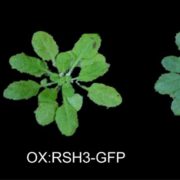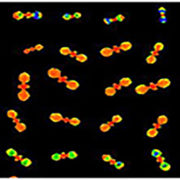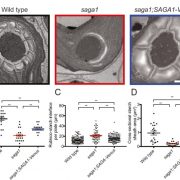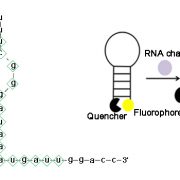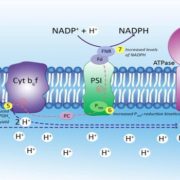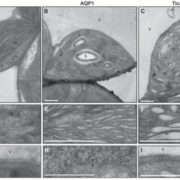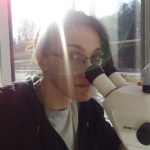The photobiology paradox resolved: photoreceptors drive photosynthesis and vice-versa
Charlotte Gommers, Assistant Features Editor
For a long time, the study of light fueled two independent fields of plant sciences. On the one hand, light energy is absorbed in the chloroplasts, to drive sugar production via photosynthesis. On the other hand, light is an environmental signal that steers plant development. Even though most light-driven growth and development aims to secure light capture for photosynthesis, the bridge between understanding light as a source of energy and light as a signal has hardly ever been made. Until now.
Plants gather information about their light environment via a collection of specialized photoreceptors, particularly phytochromes (phys) and cryptochromes (crys). Many of the pathways mediated by these photoreceptors optimize light harvesting, such as the shade avoidance syndrome to outgrow (future) neighboring plants (Fraser et al., 2016) and phototropism to move leaves towards the light (Goyal et al., 2013). When etiolated seedlings first see the light, photoreceptor activation induces a transition which prepares the seedling for a photoautotrophic life. This transition is referred to as photomorphogenesis: cotyledons separate, etioplasts develop into mature chloroplasts and the hypocotyl stops elongating (Gommers and Monte, 2018).
Upon exposure to light, phys and crys inactivate repressors of photomorphogenesis, among which is the E3 ubiquitin ligase CONSTITUTIVELY PHOTOMORPHOGENIC1 (COP1). The inactivation of COP1 releases an important promotor of photomorphogenesis, the bZIP transcription factor ELONGATED HYPOCOTYL5 (HY5). HY5 is named after its role in repressing hypocotyl elongation but turns out to be one of the major regulators of many light-driven processes above- and belowground. In addition to its role in photomorphogenesis, HY5 promotes the transcription of nuclear genes with a role in photosynthesis, such as those encoding enzymes involved in the biosynthesis of chlorophyll and carotenoids (Toledo-Ortiz et al., 2014). An indirect role for HY5 in photoprotection was described previously, when it was shown to be responsible for the transcription of enzymes of the anthocyanin biosynthesis pathway (Richter et al., 2020). These red pigments protect plants against high light by absorbing excess photons.
Recently in Plant Physiology, Li et al. (2020) built another strong connection between the HY5-mediated light signaling pathway and photosynthesis. They show that among the direct targets of HY5 is HIGH CHLOROPHYLL FLUORESCENCE173 (HCF173), encoding a chloroplast-localized protein involved in the translation of the chloroplast gene photosystem II reaction center protein A (psbA). psbA encodes the PSII reaction center protein D1, which is quickly turned over in light and needs to be constantly synthesized to maintain PSII light harvesting. Accordingly, Li et al. discover that the hy5 loss of function mutant has reduced PSII activity under white, blue, red and far-red light. This work by Li et al. provides a direct link between HY5 activity and the assembly of PSII in the chloroplast, and they additionally found that HY5 is important for PSII maintenance, as it transcribes a set of PSII repair genes. As a consequence, hy5 seedlings suffer significantly more from high light-induced photodamage than the wild type controls.
The direct involvement of HY5 in the assembly and repair of both nuclear and plastid-encoded photosynthesis proteins is novel. It builds a bridge between the photobiologists studying photoreceptor signaling on one side, and the ones studying photosynthesis on the other. Given the wealth of functions already assigned to HY5, most readers will not be surprised that this transcription factor is one of the bridge’s pillars.
An outstanding question is whether the role of HY5 in PSII repair is triggered by excess light. Besides the photoreceptor-mediated stabilization of HY5, a photoreceptor-independent pathway exists that might play an important role. Damage done to chloroplasts can trigger the release of retrograde signals from the organelle towards the nucleus (de Souza et al., 2017). Retrograde signals induced by chloroplast inhibiting chemicals or high light inhibit photomorphogenesis and anthocyanin synthesis with interplay of HY5 (Ruckle and Larkin, 2009; Martín et al., 2016; Richter et al., 2020). If light stress in the chloroplast triggers a regulatory feedback loop towards HY5 in the nucleus, it means that the newly built bridge can be walked both ways: Photoreceptors drive photosynthesis and chloroplast-derived signals in turn affect the downstream targets of photoreceptors. The photobiology paradox is starting to disappear, but more work is needed to define the key role of HY5 and identify the other pillars.
Literature Cited
de Souza A, Wang J-Z, Dehesh K (2017) Retrograde Signals: Integrators of Interorganellar Communication and Orchestrators of Plant Development. Annual Review of Plant Biology 68: 85-108
Fraser DP, Hayes S, Franklin KA (2016) Photoreceptor crosstalk in shade avoidance. Current Opinion in Plant Biology 33: 1-7
Gommers CMM, Monte E (2018) Seedling establishment: a dimmer switch-regulated process between dark and light signaling. Plant Physiology 176: 1061-1074
Goyal A, Szarzynska B, Fankhauser C (2013) Phototropism: at the crossroads of light-signaling pathways. Trends in Plant Science 18: 393-401
Martín G, Leivar P, Ludevid D, Tepperman JM, Quail PH, Monte E (2016) Phytochrome and retrograde signalling pathways converge to antagonistically regulate a light-induced transcriptional network. Nature Communications 7: 11431
Richter AS, Tohge T, Fernie AR, Grimm B (2020) The genomes uncoupled-dependent signalling pathway coordinates plastid biogenesis with the synthesis of anthocyanins. Philosophical Transactions of the Royal Society B: Biological Sciences 375: 20190403
Ruckle ME, Larkin RM (2009) Plastid signals that affect photomorphogenesis in Arabidopsis thaliana are dependent on GENOMES UNCOUPLED 1 and cryptochrome 1. New Phytologist 182: 367-379
Toledo-Ortiz G, Johansson H, Lee KP, Bou-Torrent J, Stewart K, Steel G, Rodríguez-Concepción M, Halliday KJ (2014) The HY5-PIF Regulatory Module Coordinates Light and Temperature Control of Photosynthetic Gene Transcription. PLoS Genetics 10



